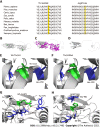Novel compound heterozygous mutation of SLC12A3 in Gitelman syndrome co-existent with hyperthyroidism: A case report and literature review
- PMID: 36158002
- PMCID: PMC9353888
- DOI: 10.12998/wjcc.v10.i21.7483
Novel compound heterozygous mutation of SLC12A3 in Gitelman syndrome co-existent with hyperthyroidism: A case report and literature review
Abstract
Background: Gitelman syndrome (GS) is a rare inherited autosomal recessive tubulopathy, characterized clinically by hypokalemia, hypomagnesemia, hypocalciuria, and metabolic alkalosis, and is caused by an inactivating mutation in SLC12A3. GS is prone to misdiagnosis when occurring simultaneously with hyperthyroidism. It is important to consider the possibility of other diseases when hyperthyroidism is combined with hypokalemia, which is difficult to correct.
Case summary: A female patient with hyperthyroidism complicated with limb weakness was diagnosed with thyrotoxic hypokalemic periodic paralysis for 4 mo. However, the patient's serum potassium level remained low despite sufficient potassium replacement and remission of hyperthyroidism. GS was confirmed by whole exome and Sanger sequencing. Gene sequencing revealed compound heterozygous mutations of c.488C>T (p.Thr163Met), c.2612G>A (p.Arg871His), and c.1171_1178dupGCCACCAT (p.Ile393fs) in SLC12A3. Protein molecular modeling was performed to predict the effects of the identified missense mutations. All three mutations cause changes in protein structure and may result in abnormal protein function. All previously reported cases of GS coexisting with autoimmune thyroid disease are reviewed.
Conclusion: We have identified a novel compound heterozygous mutation in SLC12A3. The present study provides new genetic evidence for GS.
Keywords: Case report; Gene sequencing; Gitelman syndrome; Hyperthyroidism; Hypokalemia; SLC12A3.
©The Author(s) 2022. Published by Baishideng Publishing Group Inc. All rights reserved.
Conflict of interest statement
Conflict-of-interest statement: All the authors report no relevant conflicts of interest for this article.
Figures




Similar articles
-
Concurrent Gitelman Syndrome and Hyperthyroidism: Diagnostic Challenges in a 51-Year-Old Patient.Am J Case Rep. 2024 Aug 30;25:e944909. doi: 10.12659/AJCR.944909. Am J Case Rep. 2024. PMID: 39210578 Free PMC article.
-
A novel homozygous SLC12A3 mutation causing Gitelman syndrome with co-existent autoimmune thyroiditis: a case report and review of the literature.CEN Case Rep. 2024 Oct;13(5):330-338. doi: 10.1007/s13730-023-00845-z. Epub 2024 Feb 3. CEN Case Rep. 2024. PMID: 38308744 Free PMC article. Review.
-
A novel compound heterozygous variant of the SLC12A3 gene in Gitelman syndrome with diabetes and the choices of the appropriate hypoglycemic drugs: a case report.BMC Med Genomics. 2021 Aug 4;14(1):198. doi: 10.1186/s12920-021-01047-1. BMC Med Genomics. 2021. PMID: 34348722 Free PMC article.
-
Novel compound heterozygous variants of SLC12A3 gene in a Chinese patient with Gitelman syndrome: a case report.Front Genet. 2023 Jun 12;14:1067242. doi: 10.3389/fgene.2023.1067242. eCollection 2023. Front Genet. 2023. PMID: 37377595 Free PMC article.
-
A novel compound heterozygous mutation of SLC12A3 gene in a pedigree with Gitelman syndrome and literature review.Genes Genomics. 2020 Sep;42(9):1035-1040. doi: 10.1007/s13258-020-00960-6. Epub 2020 Jul 25. Genes Genomics. 2020. PMID: 32712837 Review.
Cited by
-
Concurrent Gitelman Syndrome and Hyperthyroidism: Diagnostic Challenges in a 51-Year-Old Patient.Am J Case Rep. 2024 Aug 30;25:e944909. doi: 10.12659/AJCR.944909. Am J Case Rep. 2024. PMID: 39210578 Free PMC article.
-
A novel homozygous SLC12A3 mutation causing Gitelman syndrome with co-existent autoimmune thyroiditis: a case report and review of the literature.CEN Case Rep. 2024 Oct;13(5):330-338. doi: 10.1007/s13730-023-00845-z. Epub 2024 Feb 3. CEN Case Rep. 2024. PMID: 38308744 Free PMC article. Review.
-
Prevalence and Related Factors of Hypokalemia in Patients with Acute Ischemic Stroke.Int J Gen Med. 2024 Nov 30;17:5697-5705. doi: 10.2147/IJGM.S492025. eCollection 2024. Int J Gen Med. 2024. PMID: 39635664 Free PMC article.
References
-
- Gitelman HJ, Graham JB, Welt LG. A new familial disorder characterized by hypokalemia and hypomagnesemia. Trans Assoc Am Physicians. 1966;79:221–235. - PubMed
-
- Simon DB, Nelson-Williams C, Bia MJ, Ellison D, Karet FE, Molina AM, Vaara I, Iwata F, Cushner HM, Koolen M, Gainza FJ, Gitleman HJ, Lifton RP. Gitelman's variant of Bartter's syndrome, inherited hypokalaemic alkalosis, is caused by mutations in the thiazide-sensitive Na-Cl cotransporter. Nat Genet. 1996;12:24–30. - PubMed
-
- Abbasi B, Sharif Z, Sprabery LR. Hypokalemic thyrotoxic periodic paralysis with thyrotoxic psychosis and hypercapnic respiratory failure. Am J Med Sci. 2010;340:147–153. - PubMed
-
- Frese E, Brown M, Norton BJ. Clinical reliability of manual muscle testing. Middle trapezius and gluteus medius muscles. Phys Ther. 1987;67:1072–1076. - PubMed
-
- Zelikovic I, Szargel R, Hawash A, Labay V, Hatib I, Cohen N, Nakhoul F. A novel mutation in the chloride channel gene, CLCNKB, as a cause of Gitelman and Bartter syndromes. Kidney Int. 2003;63:24–32. - PubMed
Publication types
LinkOut - more resources
Full Text Sources

